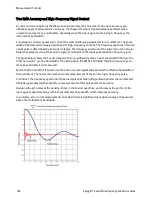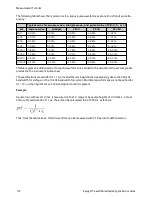
True RMS Accuracy and High–Frequency Signal Content
A common misconception is that because an AC multimeter is true rms, its sine wave accuracy spe-
cifications apply to all waveforms. Actually, the shape of the input signal dramatically affects meas-
urement accuracy for any multimeter, especially when that input signal contains high–frequency the
instrument’s bandwidth.
For example, consider a pulse train, one of the most challenging waveforms for a multimeter. The pulse
width of that waveform largely determines its high–frequency content. The frequency spectrum of an indi-
vidual pulse is determined by its Fourier Integral. The frequency spectrum of the pulse train is the Fourier
Series that samples along the Fourier Integral at multiples of the input pulse repetition frequency (prf).
The figure below shows the Fourier Integral of two very different pulses: one of broad width (200 µs); the
other narrow (6.7 µs). The bandwidth of the ACV path in the DMM is 300 kHZ; therefore, frequency con-
tent above 300 kHz is not measured.
Notice that the sin(πfT)/πfT spectrum of the narrow pulse significantly exceeds the effective bandwidth of
the instrument. The net result is a less accurate measurement of the narrow, high–frequency pulse.
In contrast, the frequency spectrum of the broad pulse has fallen off significantly below the multimeter’s
300 kHz (approximately) bandwidth, so measurements of this pulse are more accurate.
Reducing the prf increases the density of lines in the Fourier spectrum, and increases the portion of the
input signal’s spectral energy within the multimeter’s bandwidth, which improves accuracy.
In summary, error in rms measurements arise when there is significant input signal energy at frequencies
above the multimeter’s bandwidth.
Measurement Tutorial
168
Keysight True
volt
Series Operating and Service Guide
















































